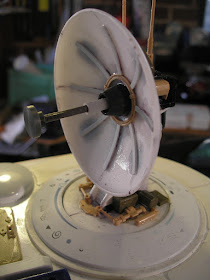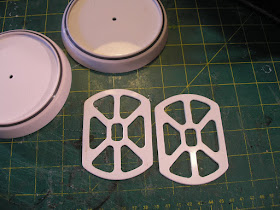The green bit is a piece of one of the rubbish truck toys from the Toybash truck project.
The light blue hand rails at the rear are heated and bent plastic knitting needles purchased cheaply from a Charity shop. Knitting needles are a good source of solid plastic rod that can be bent without flattening out with a little heat and they glue nicely with the usual solvent adhesive.
You can see the under structure with a couple of holes that I covered up. I was originally going with some round vents here but changed my mind.
The communications dish sits in a well. The circular shape surrounding the well is the outer dial from a washing machine made from good quality ABS. The dish itself is made from another cut down battery powered push activated light. There are two sizes of these, this being the smaller one, the larger is the one cut in half on each side of the rear hull. These I find at the hardware store, the small ones come two to a pack and are much cheaper and more readily available than equivalent EMA elliptical vessel heads.
The dish will be position-able but not motorised.
The next task I started on was the side hatches.
I bought some dummy ccd camera housings for the clear plastic domes (for another project) on ebay.
The bases for the domes were cut down and employed for the hatch surrounds. I needed a short tube to mate with the curved side of the hull. After much thought and not finding any pvc tube the right size a came up with a fabricated solution. I used this handy online tubing coping calculator to print out a paper pattern to cut some 1mm styrene sheet to the fish mouthed intersecting shape fitting the hull curve. You enter in the dimensions of the two intersecting tube sizes. the thickness of the cutting tube , in this case 1mm styrene and the angle here being 90 degrees. Basically I made two sine wave shapes which are each 180 degrees of the tube. First I cut a circle of 2mm styrene 2mm under size in diameter and then placed a central former with the arc of the hull cutaway. To this central spine I added various depth strips to match the curve. Then this structure was wrapped with the 1mm styrene sine shapes. A sheet of coarse sandpaper was then wrapped around the hull curve and the whole inner structure sanded to suit. Although the black styrene makes it hard to see, it fits pretty well and only a tiny amount of filling will be required.
Once I had the surround sorted I drew up a suitable hatch shape in Draft Sight and printed it out full size. All the corner radiuses get a centre mark. This paper was glued with ordinary UHU stick glue onto two pieces of 2mm styrene stuck together with Scotch brand double sided tape as I needed two of them, one for each side. The center marks were first drilled out with a 2mm drill and then followed up by an 8mm step drill, all the rounded corners having a 4mm radius. Then I dug out the old scroll saw (the same one I used to make the aluminium chassis frames) and sawed between the holes finishing up with some filing and then rounding the front surface edges by scraping with a 150mm (6") metal ruler.
A further charity shop find, a strange pleasant sounds maker designed to help people go to sleep, is going to be a sensor dome on the hull at the front. This is just the top of it, the base having been removed.
Part 1, Part 2, Part 3, Part 4, Part 5, Part 6, Part 7,
























